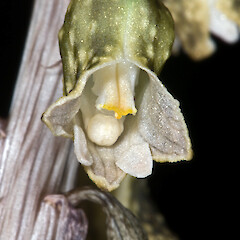Gastrodia molloyi
Common name
Molloy’s potato orchid
Synonyms
None—first described in 2016.
Family
Orchidaceae
Flora category
Vascular – Native
Endemic taxon
Yes
Endemic genus
No
Endemic family
No
Structural class
Orchids
Current conservation status
The conservation status of all known New Zealand vascular plant taxa at the rank of species and below were reassessed in 2017 using the New Zealand Threat Classification System (NZTCS) – more information about this can be found on the NZTCS website. This report includes a statistical summary and brief notes on changes since 2012 and replaces all previous NZTCS lists for vascular plants.
Please note, threat classifications are often suggested by authors when publications fall between NZTCS assessment periods – an interim threat classification status has not been assessed by the NZTCS panel.
- Conservation status of New Zealand indigenous vascular plants, 2017 . 2018. Peter J. de Lange, Jeremy R. Rolfe, John W. Barkla, Shannel P. Courtney, Paul D. Champion, Leon R. Perrie, Sarah M. Beadel, Kerry A. Ford, Ilse Breitwieser, Ines Schönberger, Rowan Hindmarsh-Walls, Peter B. Heenan and Kate Ladley. Department of Conservation. Source: NZTCS and licensed by DOC for reuse under the Creative Commons Attribution 4.0 International licence.
2017 | Not Threatened
Brief description
A terrestrial, saprophytic orchid (all parts without chlorophyll). Plants with tubers, producing numerous stems. Flowers numerous pendulous, golden-brown to dark green, fragrant.
Distribution
Endemic. New Zealand: North Island (widespread from South Auckland southwards), South Island, Stewart Island/Rakiura.
Habitat
Gastrodia molloyi is often found in disturbed sites including, willow car, flood-prone waterways, tracksides where it may be found growing amongst exotic weeds and grasses, and in forests (especially silver beech (Lophozonia menziesii) forest. It is also known from indigenous forests dominated by tawa (Beilschmiedia tawa), rawirinui (Kunzea robusta), Nothofagaceae and scrublands dominated by Kunzea species or kahikato (Leptospermum scoparium agg.).
Detailed description
Terrestrial, saprophytic, leafless, achlorophyllous herb. Plant 296–800 mm tall at flowering. Rhizome tuberous, pale brown to blackish, often covered in papery scales. Stem solitary, glabrous, golden brown to pale pink-greyish, with gray-whitish longitudinal streaks; 1.8–8.5 mm diameter. Stem bracts 3–5, papery, glabrous, sheathing. Inflorescence erect, terminal, flowers 12–55, densely arranged, non-resupinated, nectarless, scented, erect when developing and pendulous at anthesis. Floral bract papery, glabrous, deltoid, apex acute, 3.3–9.3 × 1.8–2.7 mm. Pedicel 1.1–6.6 mm long. Perianth tube 7.7–14.1 × 2.3–7.6 mm, greenish gold to golden brown, surface with pale green to gray wart-like elevations. Sepals slightly reflexed, white to pale green abaxially; margin entire to slightly irregular towards the apex; apex acuminate. Petals adnate to the tube formed by the sepals, oblong, 2.7–4.4 × 1.3–2.0 mm, white on both sides; margin irregular, apex obtuse. Labellum 7.8–10.5 mm long; adnate to the base of the perianth, fleshy. Hypochile yellow to orange, covered in pseudo-pollen, margin entire. Mesochile strongly contracted; margins entire. Epychile trilobed, white. Lateral margins incurved, entire in the basal portion then irregularly crenate to cristate towards the apex. Two bright yellow to orange, warty ridges extend from the basal section of the epychile to the middle section, where they join and extend as one towards the apex. Pseudo-pollen accumulates on both sides of the ridge. Labellum apex fleshy, yellow to orange. Column erect, 6.8–7.9 mm tall, narrow at base and wide towards the apex, 2.5–3.7 mm wide. Pollinia two. Rostellum flap like, positioned under anther, flanked by one oblong or two deltoid column wings. Stigma at base of the column, ovate. Ovary 3.4–4.3 × 6.2–8.7 mm long, brown with a few grayish wart-like elevations. Capsules upright when mature; seeds pale brown.
Manaaki Whenua Online Interactive Key
Similar taxa
Allied to Gastrodia cunninghamii, G. cooperae and G. sesamoides. The long column, which is visible in the mouth of the flower, easily distinguishes G. molloyi from Gastrodia cunninghamii, which has a short column that is not visible at the flower mouth. From G. sesamoides it can be distinguished by the greenish gold to golden brown rather than pale brown to cream or pale pink perianth, and by the tuberculate rather than smooth stem and flower surfaces. From Gastrodia cooperae, G. molloyi differs by the greenish gold to golden brown rather than dark brown to black perianth; and by labellum apex which is yellow to orange rather than brown to black.
Flowering
December–March
Flower colours
Green, Yellow
Fruiting
January–April
Propagation technique
A saprophytic species that should not be removed from the wild.
Threats
Gastrodia molloyi is widespread throughout most of NZ south of Auckland. It is, therefore, regarded as ‘Not Threatened’ using the criteria of Townsend et al. (2008)
Etymology
gastrodia: Belly tooth (flower centre)
molloyi: The epithet “molloyi” honours Brian P. J. Molloy (1930–) an eminent New Zealand botanist, biosystematist, ecologist, and conservationist. Molloy’s taxonomic interest covered New Zealand conifers, Melicytus, Pachystegia, Hebe, Leucogenes and especially New Zealand orchids.
Attribution
Fact Sheet prepared for NZPCN by P.J. de Lange (2 October 2016). Description from Lehnebach et al. (2016)
References and further reading
Lehnebach CA, Rolfe JR, Gibbins J, Ritchie P. 2016. Two new species of Gastrodia (Gastrodieae, Orchidaceae) endemic to New Zealand. Phytotaxa 277: 237–254. https://doi.org/10.11646/PHYTOTAXA.277.3.2.
Rolfe J. 2017. Guide to New Zealand Gastrodia (Orchidaceae) (pdf, 5Mb).
Townsend AJ, de Lange PJ, Norton DA, Molloy J, Miskelly C, Duffy C. 2008. New Zealand Threat Classification manual. Department of Conservation, Wellington, NZ. 35 p. https://www.doc.govt.nz/globalassets/documents/science-and-technical/sap244.pdf.
NZPCN Fact Sheet citation
Please cite as: de Lange, P.J. (Year at time of access): Gastrodia molloyi Fact Sheet (content continuously updated). New Zealand Plant Conservation Network. https://www.nzpcn.org.nz/flora/species/gastrodia-molloyi/ (Date website was queried)










